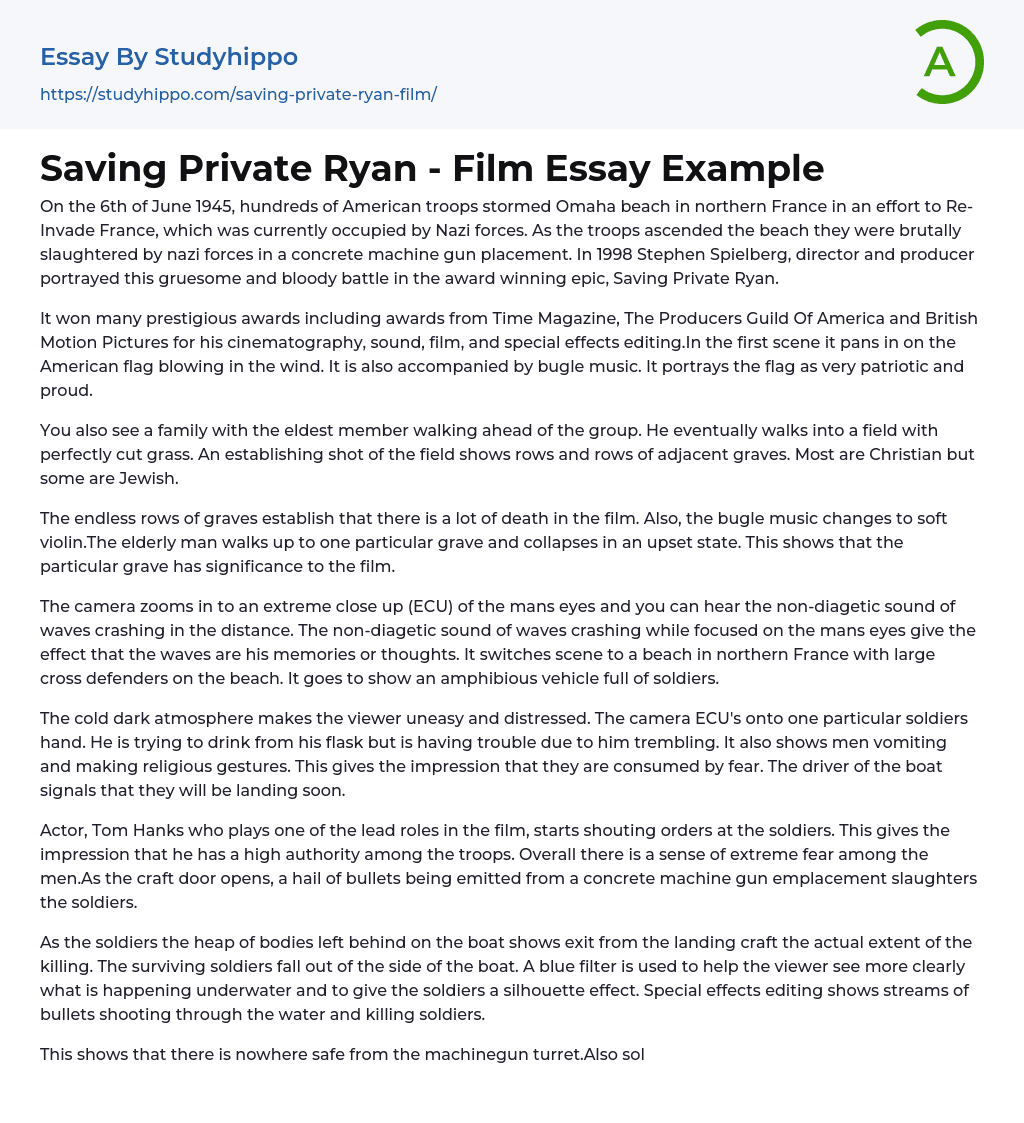In an attempt to reclaim France from Nazi occupation, numerous American soldiers stormed northern France's Omaha beach on June 6, 1945. The troops suffered immense casualties from Nazi forces positioned in a concrete machine gun emplacement. Over five decades later, Stephen Spielberg won acclaim for his vivid depiction of the horrific battle in the film Saving Private Ryan.
For its cinematography, sound, film, and special effects editing, the movie received accolades from highly respected institutions such as Time Magazine, The Producers Guild of America, and British Motion Pictures. The opening scene features the American flag billowing in the wind, accompanied by bugle music, presenting a patriotic and proud representation of the flag.
As you observe, a family leads with their eldest member as they make their way towards a field boasting an immaculately manicured lawn. Upon reaching th
...e field, an establishing shot reveals numerous adjacent graves, the majority of which are Christian with a few being Jewish.
The film depicts numerous graves, indicating a significant amount of death. Additionally, the bugle music transitions into a gentle violin melody. A grieving elderly man approaches a specific grave and collapses in emotional distress, underscoring the grave's significance to the story.
The man's eyes are shown in an extreme close up (ECU), accompanied by non-diagetic audio of waves crashing in the distance. This creates the effect of the waves being his thoughts or memories. The scene then changes to a beach in northern France, where large cross defenders can be seen and an amphibious vehicle filled with soldiers is visible.
The unsettling, frigid atmosphere triggers unease and distress in the viewer. The camera focuses closely on a soldier's trembling hand
as he tries to drink from his flask. Other soldiers can be seen vomiting and making religious gestures, indicating fear has consumed them. The boat's driver signals that they will soon reach their landing spot.
Tom Hanks, the actor portraying a commanding role in the movie, shouts orders to the soldiers implying that he holds significant authority over them. The soldiers appear to be extremely fearful, and as soon as the craft door opens, they are met with a barrage of bullets from a concrete machine gun emplacement resulting in massive casualties.
The soldiers leaving the landing craft revealed the magnitude of the killing through the pile of bodies left on the boat. As they disembarked, the surviving soldiers tumbled out. To enhance visibility underwater and create a silhouette effect for the soldiers, a blue filter was employed. The use of special effects produced scenes of bullets piercing through the water and taking down soldiers.
Despite soldiers getting tangled in their straps and drowning from panic, there seems to be no safe place from the machinegun turret as the men ascend a beach stained with a potent red color from blood. Additionally, bombs from the hills are being fired onto the beach, further indicating the extent of killing.
During a scene, a bomb ignites a fire, with prosthetic limbs being used frequently to depict the damage caused by the explosion. However, their impact decreases later in the scene. Additionally, one of the bombs lands near Tom Hanks, causing him temporary deafness.
In the film, a moment of silence is created, providing a brief respite from the accompanying noise. This allows the viewer to gain an understanding of the scene,
depicting Tom's comrades being killed in pursuit of reaching the beach. The film is produced with the intent to display war as a horrifying experience, a perspective also seen in earlier films predating the Vietnam era.
While "The Longest Day" may suggest that war has positive aspects, this film portrays war as a tragic event that results in immense fatalities.
- 12 Angry Men essays
- A beautiful mind essays
- A Separation essays
- Alfred Hitchcock essays
- American Beauty essays
- American Films essays
- Animation essays
- Avatar essays
- Blade Runner essays
- Bollywood essays
- Bond essays
- Bridge essays
- Cinema Of The United States essays
- Comedies essays
- David essays
- Dead Poets Society essays
- Do The Right Thing essays
- Documentary essays
- English-Language Films essays
- Erin Brockovich essays
- Film Analysis essays
- Film Editing essays
- Film Noir essays
- Film Techniques essays
- Finding Forrester essays
- Forrest Gump essays
- Gattaca essays
- Gladiator essays
- Glory essays
- Good Will Hunting essays
- Hamilton essays
- Hollywood essays
- Horror essays
- Jaws essays
- King kong essays
- Like Water For Chocolate essays
- Looking For Alibrandi essays
- Martin Scorsese essays
- Melodrama essays
- Monster essays
- Moulin rouge essays
- Movie Analysis essays
- Movie Review essays
- On The Waterfront essays
- One Flew Over The Cuckoo'S Nest essays
- Our day out essays
- Pearl Harbor (Movie) essays
- Persepolis essays
- Pornography essays
- Rabbit Proof Fence essays




